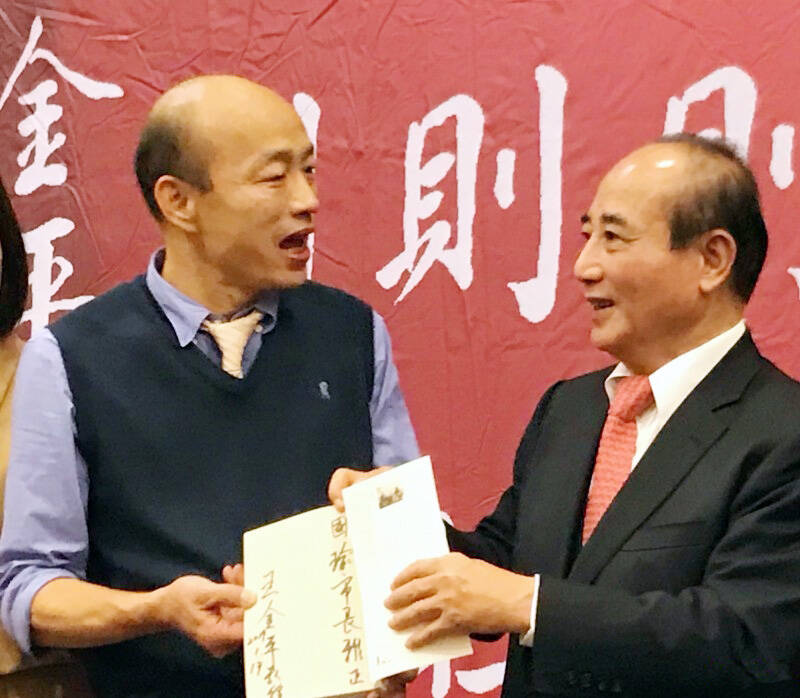Many will be surprised to discover that the electoral voting numbers in recent elections do not entirely line up with what the actual voting results show.
Swing voters decide elections, but in recent elections, the results offer a different and surprisingly consistent message.
And there is one overarching theme: a very democratic preference for balance.

Photo: TT file photo
SOME CAVEATS
Putting a number on the number of swing voters is surprisingly slippery. Because swing voters favor different parties depending on the type of election, it is hard to separate die-hard voters leaning towards one party or the other.
Complicating matters is that some voters are not voting for a party, but because they hate another party. An interesting series of polls in 2022 conducted by Chinese-language RW News showed that in many regions, more Chinese Nationalist Party (KMT) voters picked them because they hated the Democratic Progressive Party (DPP) more so than because they actually liked the KMT, and vice versa.
LESS SURPRISING, WOMEN RISING
There is one pattern that is not surprising: a steady rise in preference for women candidates at all levels of government.
In the 2022 local elections, the KMT heavily promoted that they were running female candidates for 10 of the 22 city and county leaders, while the DPP only ran five. The KMT’s strategy was solid, and most of their candidates won, and in total 10 of the 22 elected were women, or 45 percent.
In local elections for city and county councilors in 2022, the percentage of women rose to 38 percent, though excluding Kinmen and Matsu, it is around 40 percent. Analysis in The Reporter demonstrated that two-thirds of the female candidates who ran won, versus only half for the men.
The legislature is over 40 percent women, but the numbers are harder to analyze because out of the 113 legislators, the 34 party list lawmakers have a 50-50 gender quota.
This trend is likely to continue as entrenched, older male incumbents elected in a different era retire.
If it does continue, in the next two or three election cycles, the genders will be roughly in balance.
LOCAL ELECTION RESULTS NOT WHAT YOU THINK
In electoral party politics, the desire for balance expresses itself in curious ways. Prior to 2014, the KMT dominated, but the pendulum swung hard in the other direction in 2014 and 2016, delivering landslide victories to the DPP. For the first time, the DPP not only controlled both the executive and legislative branches, but also a majority of the cities and counties.
The 2018 local elections were dominated by discussion of the “Han wave” sparked by the charismatic Han Kuo-yu (韓國瑜). Behind the scenes, former legislative speaker Wang Jin-pyng (王金平) orchestrated a unified front by the KMT’s local factions and steered Han’s campaign.
It was a brilliant landslide victory for the KMT, largely thanks to Wang, who had sidelined the feckless KMT chairman Wu Den-yih (吳敦義).
Now dominating government at the local level, the KMT provided something of a counterweight to the DPP. At the time, it appeared to be a one-off, but the 2022 local elections suggest two possible patterns that had little to do with Wang’s brilliance.
In 2022, the DPP’s electoral strategy was one disastrous misstep after another, while the KMT outclassed them across the board.
However, the electorate appears to have been giving the same messages as in 2018, including giving the DPP a warning by delivering another KMT landslide victory, following two landslide victories on the national level for the DPP.
Particularly striking is the voting numbers barely budged. Despite lacking a “wave” or charismatic frontrunner, in 2022 the KMT won by a slightly higher 50.1 percent of the total popular vote compared to 48.8 percent in 2018. The DPP’s vote was also similar, at 39.7 percent in 2018 and 41.6 in 2022.
While on the national level, public opinion is closer to the DPP on sovereignty, handling the challenges posed by Beijing and foreign policy, none of these advantages are relevant in local government, where voters clearly prefer the KMT. Some parts of the country — notably Taichung and Changhua counties — local DPP leaders suffer from what is called the “one-term curse.”
NUMBERS AT ODDS WITH THE NARRATIVE
The DPP does have advantages on the national level, though the picture is more nuanced and than many assume.
They have won the presidency three times in a row. In a previous column, we examined the numbers in detail, showing that President William Lai (賴清德) would likely have won in a two-way race against the KMT, but it would have been a close race.
Despite very different outcomes, what is striking about the 2020 and last year’s legislative election results is that they were identical in total voter numbers. The DPP’s loss of 10 seats and the KMT’s gain of 14 had more to do with electoral math than voter support.
Across the nation, in constituency voting, the DPP won 45.11 percent of the total vote in 2020 and 45.09 last year, dropping only .02 percent. The KMT won 40.71 percent in 2020, and even dropped to 39.96 last year — but they got the votes where they needed to win more seats.
The DPP actually increased their vote in the party list proportional representation legislative vote last year at 36.16 percent, up from 33.98 in 2020. The KMT got 33.36 in 2020 and 34.58 percent last year, but in spite of the KMT getting less votes each time, the differences between the parties were small enough that they tied in the party list legislators assigned to the parties both times.
In both elections, third parties won eight party list seats. The New Power Party (NPP) won three seats, and the Taiwan People’s Party (TPP) five in 2020, with the TPP winning all eight last year.
In aggregate, the voters delivered almost exactly the same messages in 2018, 2020, 2022 and last year. The numbers are essentially identical.
Swing voters preferred the KMT to run their local government, gave the DPP the presidency and their local lawmaker, and split the difference between the two parties on the party list, while giving third parties the balance of power.
That the DPP lost so many legislative seats last year is likely down to KMT Chairman Eric Chu’s (朱立倫) skills in getting out the vote where it was needed most in key constituencies, despite winning a slightly lower percentage of the vote overall. DPP Chairman William Lai failed to get the votes where they counted, in spite of winning overall.
During the recent recall campaigns, first the KMT was utterly crushed in their attempts to unseat DPP lawmakers, then once the DPP got directly involved in backing the campaigns to unseat KMT lawmakers, they were similarly devastated.
The lesson for both the DPP and KMT is that what swing voters give with one hand, they take with the other. Neither party is fully trusted, and swing voters want each party to provide a check on the other.
Donovan’s Deep Dives is a regular column by Courtney Donovan Smith (石東文) who writes in-depth analysis on everything about Taiwan’s political scene and geopolitics. Donovan is also the central Taiwan correspondent at ICRT FM100 Radio News, co-publisher of Compass Magazine, co-founder Taiwan Report (report.tw) and former chair of the Taichung American Chamber of Commerce. Follow him on X: @donovan_smith.

Oct. 27 to Nov. 2 Over a breakfast of soymilk and fried dough costing less than NT$400, seven officials and engineers agreed on a NT$400 million plan — unaware that it would mark the beginning of Taiwan’s semiconductor empire. It was a cold February morning in 1974. Gathered at the unassuming shop were Economics minister Sun Yun-hsuan (孫運璿), director-general of Transportation and Communications Kao Yu-shu (高玉樹), Industrial Technology Research Institute (ITRI) president Wang Chao-chen (王兆振), Telecommunications Laboratories director Kang Pao-huang (康寶煌), Executive Yuan secretary-general Fei Hua (費驊), director-general of Telecommunications Fang Hsien-chi (方賢齊) and Radio Corporation of America (RCA) Laboratories director Pan

President William Lai (賴清德) has championed Taiwan as an “AI Island” — an artificial intelligence (AI) hub powering the global tech economy. But without major shifts in talent, funding and strategic direction, this vision risks becoming a static fortress: indispensable, yet immobile and vulnerable. It’s time to reframe Taiwan’s ambition. Time to move from a resource-rich AI island to an AI Armada. Why change metaphors? Because choosing the right metaphor shapes both understanding and strategy. The “AI Island” frames our national ambition as a static fortress that, while valuable, is still vulnerable and reactive. Shifting our metaphor to an “AI Armada”

When Taiwan was battered by storms this summer, the only crumb of comfort I could take was knowing that some advice I’d drafted several weeks earlier had been correct. Regarding the Southern Cross-Island Highway (南橫公路), a spectacular high-elevation route connecting Taiwan’s southwest with the country’s southeast, I’d written: “The precarious existence of this road cannot be overstated; those hoping to drive or ride all the way across should have a backup plan.” As this article was going to press, the middle section of the highway, between Meishankou (梅山口) in Kaohsiung and Siangyang (向陽) in Taitung County, was still closed to outsiders

The older you get, and the more obsessed with your health, the more it feels as if life comes down to numbers: how many more years you can expect; your lean body mass; your percentage of visceral fat; how dense your bones are; how many kilos you can squat; how long you can deadhang; how often you still do it; your levels of LDL and HDL cholesterol; your resting heart rate; your overnight blood oxygen level; how quickly you can run; how many steps you do in a day; how many hours you sleep; how fast you are shrinking; how